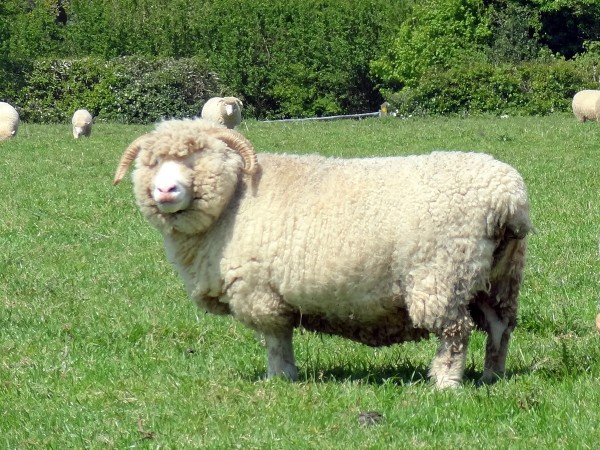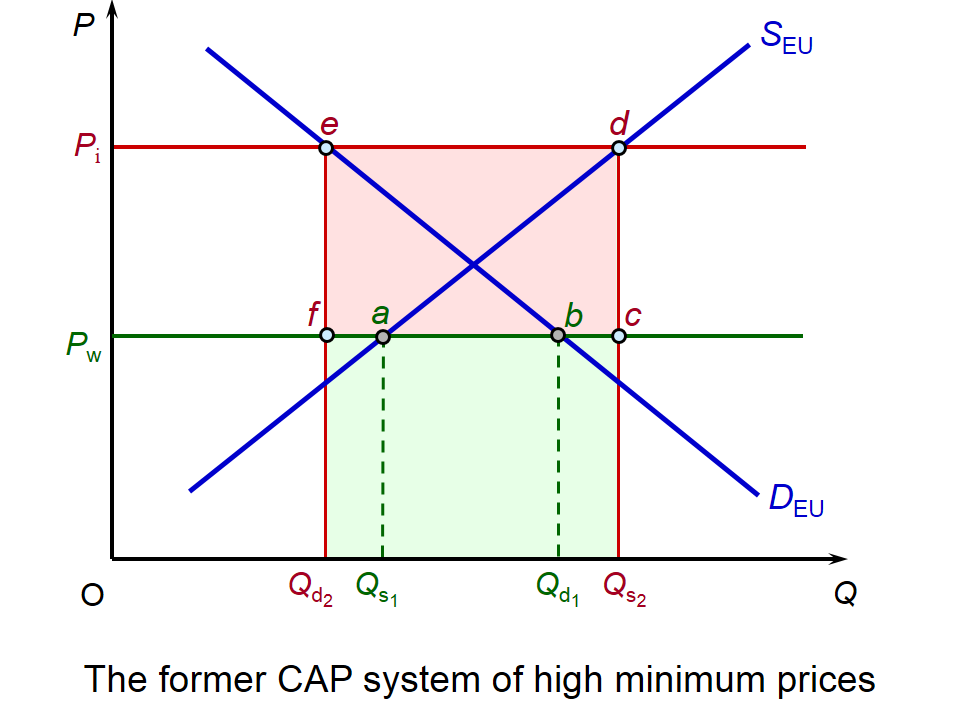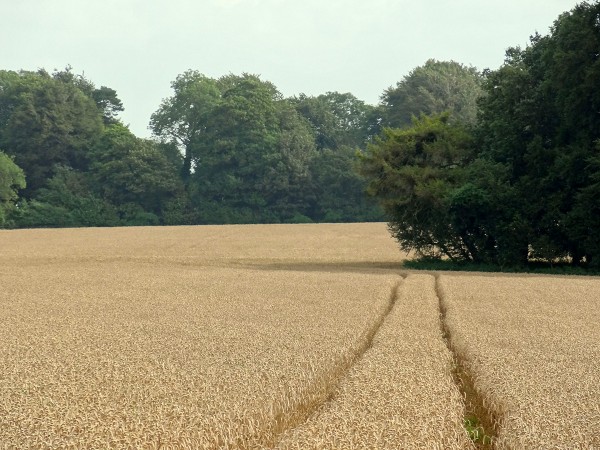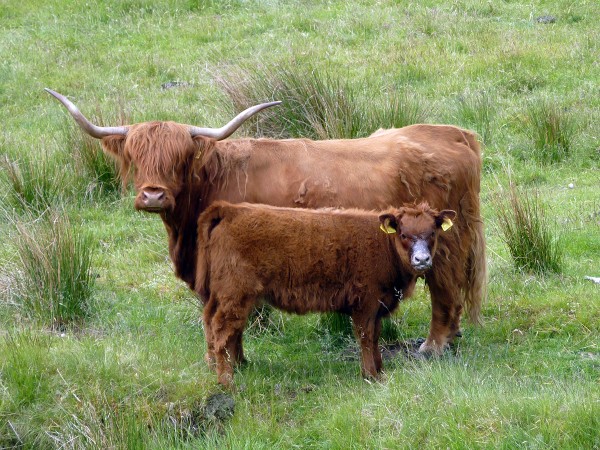 The European Parliament, Council and Commission have agreed on reform to the Common Agricultural Policy as part of the EU’s long-term budget settlement for 2014–20. The CAP accounts for some 38% of the EU’s budget and, over the years, has drawn considerable criticism for resulting in food mountains and support being biased towards large intensive farms.
The European Parliament, Council and Commission have agreed on reform to the Common Agricultural Policy as part of the EU’s long-term budget settlement for 2014–20. The CAP accounts for some 38% of the EU’s budget and, over the years, has drawn considerable criticism for resulting in food mountains and support being biased towards large intensive farms.
As section 3.5 in Economics (8th ed) explains, the CAP has been through a number of reforms since the early 1990s. Prior to that, the main form of support was that of guaranteed minimum prices backed up, where necessary, by levies (tariffs) on imported food. Any surplus of production at the minimum price was bought by the relevant EU Intervention Board and either stored or exported at world prices. The effect of minimum prices is shown in the diagram.
 Assume that the EU demand is DEU and that EU supply is SEU. Assume also that the world price is Pw. This will be the equilibrium price, since any shortage at Pw (i.e. b – a) will be imported at that price. Thus before intervention, EU demand is Qd1 and EU supply is Qs1 and imports are Qd1 – Qs1.
Assume that the EU demand is DEU and that EU supply is SEU. Assume also that the world price is Pw. This will be the equilibrium price, since any shortage at Pw (i.e. b – a) will be imported at that price. Thus before intervention, EU demand is Qd1 and EU supply is Qs1 and imports are Qd1 – Qs1.
Now assume that the EU sets an intervention price of Pi. At this high price, there will be a surplus of d – e (i.e. Qs2 – Qd2). Assume for the moment that none of this surplus is exported. It will all, therefore, be bought by the appropriate Intervention Board. The cost to the EU of buying this surplus is shown by the total shaded area (edQs2Qd2: i.e. the surplus multiplied by the intervention price). Unless the food is thrown away, exported or otherwise disposed of, there will obviously then be the additional costs of storing this food: costs that were very high in some years as wine ‘lakes’ and grain and dairy ‘mountains’ built up. If, however, the surplus is sold on world markets at the world price Pw, this will earn the green area for the EU, leaving a net cost of just the pink area.
 From 1992, there was a gradual move towards lowering intervention prices and paying farmers direct aid unrelated to current output. From 2004, the main form of support became these direct aid payments. Annual payments to each farm were based on the average support it had received over the three years from 2000 to 2002. At the same time, payments to large farms were gradually reduced, with 80 per cent of the money saved in each country being diverted to rural development. Payments were also made conditional on farmers making environmental improvements to their land.
From 1992, there was a gradual move towards lowering intervention prices and paying farmers direct aid unrelated to current output. From 2004, the main form of support became these direct aid payments. Annual payments to each farm were based on the average support it had received over the three years from 2000 to 2002. At the same time, payments to large farms were gradually reduced, with 80 per cent of the money saved in each country being diverted to rural development. Payments were also made conditional on farmers making environmental improvements to their land.
A problem with this system is that farmers who had high average output in the years 2000–2 have been receiving the same large payments ever since, while farmers who had small yields in those years have received correspondingly small payments.
A proposal two years ago by Dacian Cioloş, the EU Commissioner for Agriculture, was for flat-rate payments per hectare. But objections were raised that this would benefit inefficient farmers who would receive the same as efficient ones. In the end a compromise agreement was reached which saw a capping of the amount of payment per hectare. The result is that the most intensive farmers will see a reduction in their payments by some 30% – a process that will happen gradually over the period 2014–19.
 In addition it has been agreed that 30% of the direct aid payments will be conditional on farmers adopting various measures to protect the environment and wildlife.
In addition it has been agreed that 30% of the direct aid payments will be conditional on farmers adopting various measures to protect the environment and wildlife.
Farmers will have to be ‘active’ producers to receive direct aid payments. This is designed to exclude businesses such as airports or sports clubs, some of which had been receiving support under the previous system.
It was also agreed to provide 25% extra support for five years to farmers under 35 in an attempt to attract more young farmers into agriculture. Other details of the settlement are given in the EU documents, videos and articles below.
Webcasts
 The great shake-up of the Common Agricultural Policy EPP Group in the European Parliament (25/1/13)
The great shake-up of the Common Agricultural Policy EPP Group in the European Parliament (25/1/13)
 Planned reforms of Common Agricultural Policy under fire BBC News, Roger Harrabin (24/6/13)
Planned reforms of Common Agricultural Policy under fire BBC News, Roger Harrabin (24/6/13)
 Mixed response to compromise CAP deal RTE News (26/6/13)
Mixed response to compromise CAP deal RTE News (26/6/13)
 Farm reforms may not increase food production, warns MEP europeandyou, Diane Dodds MEP (26/6/13)
Farm reforms may not increase food production, warns MEP europeandyou, Diane Dodds MEP (26/6/13)
Articles
Big farms to see European subsidies slashed The Telegraph, Rowena Mason (26/6/13)
Common Agricultural Policy deal agreed at last RTE News, Damien O’Reilly (26/6/13)
CAP Reform: MEPs, Council and Commission strike deal FarmingUK (27/6/13)
EU agricultural overhaul puts onus on farmers to be green Financial Times, Joshua Chaffin (26/6/13)
CAP reform deal agreed in Brussels Farmers Guardian, Alistair Driver (26/6/13)
‘Bad for farmers and wildlife’ – CAP reform reaction Farmers Guardian, Alistair Driver (27/6/13)
EU documents
Political agreement on new direction for common agricultural policy Europa Press Release (26/6/13)
CAP Reform – an explanation of the main elements Europa Press Release (26/6/13)
Press release, 3249th Council meeting : Agriculture and Fisheries The Council of the European Union (25/6/13)
Questions
- Why will a system of agricultural support based solely on direct aid not result in any food mountains?
- Show in a diagram the effect of high minimum prices (plus import levies) on an agricultural product in which a country is not self-sufficient (and is still not made so by the high minimum price). How much will be imported before and after the intervention?
- What are the arguments for and against making direct aid payments based solely per hectare?
- Find out how sugar quotas have worked. What will be the effects of abolishing them by 2017?
- What ‘green’ measures are included in the agreement and how effective are they likely to be?
- Consider the arguments for and against removing all forms of support for agriculture in the EU.
- What are the effects of (a) price support and (b) direct aid payments unrelated to output for EU farmers on farmers in developing countries producing agricultural products in competition with those produced in the EU?
- Why may the environmental measures in the new agreement be seen as too weak?
 A simple model in economics is that of demand and supply. Through the price mechanism, signals are sent between consumers and producers and this interaction results in an equilibrium market price and quantity. However, what happens when the market for a good or service is in disequilibrium?
A simple model in economics is that of demand and supply. Through the price mechanism, signals are sent between consumers and producers and this interaction results in an equilibrium market price and quantity. However, what happens when the market for a good or service is in disequilibrium?
When a market is in equilibrium, demand equals supply. However, as we discussed in a previous blog concerning baby milk in China (see Milking the economy), markets are not always in equilibrium. If demand exceeds supply, a shortage will emerge and to eliminate this, the price must rise. If, on the other hand, supply exceeds demand, there will be an excess supply and thus the price must fall to restore equilibrium.
The market in question here is toilet paper in Venezuela! A severe shortage of this product has emerged in recent months, with shops running out of supplies. In a bid to relieve this shortage, the country’s Minister of Commerce has received approval for a $79 million credit, which can be used to import this basic product in short supply. Fifty million rolls will be imported to help fill the shortage that has emerged. The shortage is not just a problem for toilet paper, but also across a range of basic consumer goods. The article from Reuters comments that:
The government says the toilet paper shortages, like others, are the results of panicked buying and unscrupulous merchants hoarding the goods to artificially inflate prices.
Opposition critics say the problem is caused by the currency controls, created a decade ago by late socialist leader Hugo Chavez, and years of nationalizations that weakened private industry and left businesses unwilling to invest.
With shortages across a variety of products, the President has begun to work closely with business leaders to address this situation. The following articles consider this basic market, the intervention and consequences.
Venezuela hopes to wipe out toilet paper shortage by importing 50m rolls The Guardian (16/5/13)
Venezuela ends toilet paper shortage BBC News (22/5/13)
With even toilet paper scarce, Venezuelan president warms to business Reuters, Eyanir Chinea (22/5/13)
Toilet paper shortage in Venezuela to end after lawmakers back plans to import 39 million rolls Huffington Post, Sara Nelson (22/5/13)
Venezuela’s toilet paper shortage ended; 3 other basic goods that went scarce in the country International Business Times, Patricia Rey Mallen (22/5/13)
Questions
- Using a demand and supply diagram, explain how equilibrium is determined in a free market.
- Illustrate the shortage described in the aticles on your above demand and supply diagram. How should the price mechanism adjust?
- What types of government intervention have led to the shortages of such basic consumer goods?
- How have currency controls created a problem for Venezuela?
- With an increase in imported products, what impact might there be on Venezuela’s exchange rate and on its balance of payments?
The total EU budget in 2010 was €123 billion. Just under half of this (€58 billion) was spent on supporting agriculture. The programme of support – the Common Agricultural Policy (CAP) – has changed over the years. For a start, despite its being a large proportion of the EU budget, this proportion has actually been falling. In 1980, the CAP accounted for 69% of the EU budget; in 1990 it was 60%; in 2000 it was 52%; in 2010 it was 47%.
The types of support have also changed. The main method in the past was effectively to set minimum prices for various foodstuffs and for Intervention Boards to buy up any surpluses that arose from such prices being above the market equilibrium. Massive food ‘mountains’ resulted. Sometimes these surpluses were dumped on the world market; sometimes they were thrown away; sometimes they were simply kept in storage. Export subsidies and import levies (taxes) were also used to reduce surpluses. This, of course, was highly damaging to farmers in many countries outside the EU, especially in various primary exporting developing countries.
Reforms have taken place in recent years. The most important has been to replace high intervention prices with direct payments to farmers unrelated to current output. Whilst such payments still provide a substantial outgoing from the EU budget, being unrelated to current output, they do not encourage farmers to produce more and thus do not generate surpluses. Prices in most cases are allowed to be determined by the market.
The EU has just announced further reforms. These include:
• Capping total CAP spending at current levels until 2020
• Capping the total payment to any one farm to €300,000
• Relating subsidies to acreage rather than previous output
• Making 30% of the direct payments dependent on farmers meeting environmental criteria.
The following videos and articles examine the proposals and assess their likely benefits, their likely drawbacks and their likelihood of being implemented.
Videos
 EU plans to reform Common Agricultural Policy for farmers BBC News, Jeremy Cooke (12/10/11)
EU plans to reform Common Agricultural Policy for farmers BBC News, Jeremy Cooke (12/10/11)
 EU unveils controversial agricultural reforms Euronews (12/10/11)
EU unveils controversial agricultural reforms Euronews (12/10/11)
 Towards a new Common Agricultural Policy Euronews (14/10/11)
Towards a new Common Agricultural Policy Euronews (14/10/11)
 Queen to lose out in shake up of Europe’s farm payments Channel 4 News (12/10/11)
Queen to lose out in shake up of Europe’s farm payments Channel 4 News (12/10/11)
 Cautious welcome for EU agriculture policy shake-up STV News (12/10/11)
Cautious welcome for EU agriculture policy shake-up STV News (12/10/11)
 CAP reform proposals YouTube, Dacian Cioloş, European Commissioner for Agriculture and Rural Development (in French with English subtitles) (12/10/11)
CAP reform proposals YouTube, Dacian Cioloş, European Commissioner for Agriculture and Rural Development (in French with English subtitles) (12/10/11)
Articles
EU farm chief: CAP plans represent profound reform Reuters, Charlie Dunmore (12/10/11)
UK to dismiss Common Agricultural Policy reforms as inadequate Guardian, David Gow (11/10/11)
EU Farm Policy Debate Pits Top Receiver France Against U.K. Bloomberg Businessweek, Rudy Ruitenberg (12/10/11)
EU plans CAP reforms for ‘greener’ farm subsidies BBC News (12/10/11)
Common Agriculture Policy farm subsidy plan unveiled BBC News (12/10/11)
Q&A: Reform of EU farm policy BBC News (12/10/11)
CAP reform: Shepherd and steward of the land BBC News, Jeremy Cooke (12/10/11)
EU agriculture policy ‘still hurting farmers in developing countries’ Guardian: Poverty Matters blog, Mark Tran (11/10/11)
EU aid to farmers to continue over next decade Financial Times, Joshua Chaffin (12/10/11)
EU publications
CAP Reform – an explanation of the main elements Europa Press Release (12/10/11)
The European Commission proposes a new partnership between Europe and the farmers European Commission Press Release (12/10/11)
EU farm policy after 2013: Commission proposals welcomed with reservations European Parliament Press Release (12/10/11)
Legal proposals for the CAP after 2013 European Commission: Agriculture and Rural Development (12/10/11)
Questions
- Explain why the old system of price support under the CAP led to food surpluses. Use a diagram to illustrate your analysis.
- What is the significance of price elasticity of demand and supply in determining the size of these surpluses?
- What reforms have been introduced to the CAP in recent years? What effects have these had?
- Explain the new proposals for the CAP after 2013.
- What are the likely benefits of these proposals?
- What are the likely drawbacks of the proposals?
The market for rice has been in turmoil recently with shortages and rapid price rises. This crisis has led to Japan and the USA negotiating a deal to release the surplus rice held by Japan in silos. It is estimated that this deal would lead to around 1.5 million tonnes of rice being made available and this could help reduce the price of rice on global markets.
Japan’s silos key to relieving rice shortage Times Online (17/5/08)
Tokyo stockpiles rice while others go short Times Online (17/5/08)
Thai cartel idea outrages consumers Times Online (3/5/08)
Controlling crops goes against the grain Times Online (3/5/08)
Questions
| 1. |
Explain why Japan is holding surplus rice in silos. |
| 2. |
Assess the impact of this ‘distortion’ on the global rice market. |
| 3. |
With reference to the last two articles linked above, assess the likely impact of the cartel proposed by the Thai prime minister on the global market for rice. |
 The European Parliament, Council and Commission have agreed on reform to the Common Agricultural Policy as part of the EU’s long-term budget settlement for 2014–20. The CAP accounts for some 38% of the EU’s budget and, over the years, has drawn considerable criticism for resulting in food mountains and support being biased towards large intensive farms.
The European Parliament, Council and Commission have agreed on reform to the Common Agricultural Policy as part of the EU’s long-term budget settlement for 2014–20. The CAP accounts for some 38% of the EU’s budget and, over the years, has drawn considerable criticism for resulting in food mountains and support being biased towards large intensive farms. Assume that the EU demand is DEU and that EU supply is SEU. Assume also that the world price is Pw. This will be the equilibrium price, since any shortage at Pw (i.e. b – a) will be imported at that price. Thus before intervention, EU demand is Qd1 and EU supply is Qs1 and imports are Qd1 – Qs1.
Assume that the EU demand is DEU and that EU supply is SEU. Assume also that the world price is Pw. This will be the equilibrium price, since any shortage at Pw (i.e. b – a) will be imported at that price. Thus before intervention, EU demand is Qd1 and EU supply is Qs1 and imports are Qd1 – Qs1. From 1992, there was a gradual move towards lowering intervention prices and paying farmers direct aid unrelated to current output. From 2004, the main form of support became these direct aid payments. Annual payments to each farm were based on the average support it had received over the three years from 2000 to 2002. At the same time, payments to large farms were gradually reduced, with 80 per cent of the money saved in each country being diverted to rural development. Payments were also made conditional on farmers making environmental improvements to their land.
From 1992, there was a gradual move towards lowering intervention prices and paying farmers direct aid unrelated to current output. From 2004, the main form of support became these direct aid payments. Annual payments to each farm were based on the average support it had received over the three years from 2000 to 2002. At the same time, payments to large farms were gradually reduced, with 80 per cent of the money saved in each country being diverted to rural development. Payments were also made conditional on farmers making environmental improvements to their land. In addition it has been agreed that 30% of the direct aid payments will be conditional on farmers adopting various measures to protect the environment and wildlife.
In addition it has been agreed that 30% of the direct aid payments will be conditional on farmers adopting various measures to protect the environment and wildlife. The great shake-up of the Common Agricultural Policy EPP Group in the European Parliament (25/1/13)
The great shake-up of the Common Agricultural Policy EPP Group in the European Parliament (25/1/13) Planned reforms of Common Agricultural Policy under fire BBC News, Roger Harrabin (24/6/13)
Planned reforms of Common Agricultural Policy under fire BBC News, Roger Harrabin (24/6/13) Mixed response to compromise CAP deal RTE News (26/6/13)
Mixed response to compromise CAP deal RTE News (26/6/13) Farm reforms may not increase food production, warns MEP europeandyou, Diane Dodds MEP (26/6/13)
Farm reforms may not increase food production, warns MEP europeandyou, Diane Dodds MEP (26/6/13)